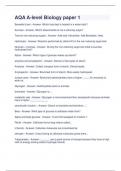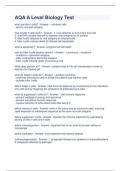Annjeonyango
On this page, you find all documents, package deals, and flashcards offered by seller annjeonyango.
- 293
- 0
- 28
Community
- Followers
- Following
321 items

Corporate Finance Examination
Corporate Finance Risk-free rate - Answer- No such thing...but many use 10 year Treasury bonds as a proxy for the risk-free rate Flotation Costs - Answer- the transaction cost incurred when a firm raises funds by issuing a particular type of security Flotation Cost Adjustment - Answer- the amount that must be added to cost of retained earnings to account for flotation costs to find cost of new common stock pure play method - Answer- a method for estimating a project's or division's ...
- Exam (elaborations)
- • 7 pages •
Corporate Finance Risk-free rate - Answer- No such thing...but many use 10 year Treasury bonds as a proxy for the risk-free rate Flotation Costs - Answer- the transaction cost incurred when a firm raises funds by issuing a particular type of security Flotation Cost Adjustment - Answer- the amount that must be added to cost of retained earnings to account for flotation costs to find cost of new common stock pure play method - Answer- a method for estimating a project's or division's ...

Corporate Finance Exam 1
Corporate Finance Financial break-even - Answer- Financial break even NPV solved=0, OCF* for NPV=0 Q=(FC+OCF*)/ (P-v) v=variable cost per unit General Break-Even - Answer- Q=(FC+OCF) /(P-v) Constant Growth Model (infinite) - Answer- a widely cited dividend valuation approach that assumes that dividends will grow at a constant rate, but a rate that is less than the required return Constant Growth Model (finite) - Answer- Should include terminal value (what you sell it for) @ end ...
- Exam (elaborations)
- • 85 pages •
Corporate Finance Financial break-even - Answer- Financial break even NPV solved=0, OCF* for NPV=0 Q=(FC+OCF*)/ (P-v) v=variable cost per unit General Break-Even - Answer- Q=(FC+OCF) /(P-v) Constant Growth Model (infinite) - Answer- a widely cited dividend valuation approach that assumes that dividends will grow at a constant rate, but a rate that is less than the required return Constant Growth Model (finite) - Answer- Should include terminal value (what you sell it for) @ end ...

AQA A-level Biology paper 1 Exam
AQA A-level Biology paper 1 Benedict's test - Answer- Which food test is heated in a water bath? Sucrose - Answer- Which disaccharide is not a reducing sugar? Test for non-reducing sugars - Answer- Add acid. Neutralise. Add Benedicts. Heat. Hydrolysis - Answer- Reaction performed by dilute HCl in the non reducing sugar test. Glucose + fructose - Answer- During the non-reducing sugar test what is sucrose hydrolysed into? Alpha - Answer- Which type of glucose makes up starch? ...
- Exam (elaborations)
- • 17 pages •
AQA A-level Biology paper 1 Benedict's test - Answer- Which food test is heated in a water bath? Sucrose - Answer- Which disaccharide is not a reducing sugar? Test for non-reducing sugars - Answer- Add acid. Neutralise. Add Benedicts. Heat. Hydrolysis - Answer- Reaction performed by dilute HCl in the non reducing sugar test. Glucose + fructose - Answer- During the non-reducing sugar test what is sucrose hydrolysed into? Alpha - Answer- Which type of glucose makes up starch? ...

Biology A-Level Questions & Answers
Biology A-Level Questions & Answers abiotic factors - Answer- non-living conditions in a habitat activation energy - Answer- the energy required to initiate a reaction. active site - Answer- area of an enzyme with a shape complementary to a specific substrate, allowing the enzyme to bind a substrate with specificity. active transport - Answer- movement of particles across a plasma membrane against a concentration gradient. Energy is required. (ATP) adenosine diphosphate (ADP) - Answ...
- Exam (elaborations)
- • 34 pages •
Biology A-Level Questions & Answers abiotic factors - Answer- non-living conditions in a habitat activation energy - Answer- the energy required to initiate a reaction. active site - Answer- area of an enzyme with a shape complementary to a specific substrate, allowing the enzyme to bind a substrate with specificity. active transport - Answer- movement of particles across a plasma membrane against a concentration gradient. Energy is required. (ATP) adenosine diphosphate (ADP) - Answ...

AQA A-level Biology Examination
AQA A-level Biology Examination Describe eukaryotic cells - Answer- They are complex cells and include all animal and plant cells, as well as all algae and fungi cells. What does it mean if a organism is eukaryotic? - Answer- It is a multi-cellular organism that is made up of eukaryotic cells. What is an organelle? - Answer- A part of a cell that plays a specific role. Name the organelles you might find in an animal cell - Answer- 1)Plasma cell surface membrane 2)Rough/smooth endoplas...
- Exam (elaborations)
- • 19 pages •
AQA A-level Biology Examination Describe eukaryotic cells - Answer- They are complex cells and include all animal and plant cells, as well as all algae and fungi cells. What does it mean if a organism is eukaryotic? - Answer- It is a multi-cellular organism that is made up of eukaryotic cells. What is an organelle? - Answer- A part of a cell that plays a specific role. Name the organelles you might find in an animal cell - Answer- 1)Plasma cell surface membrane 2)Rough/smooth endoplas...

AQA A level Biology Revision
AQA A level Biology Revision . [2] - Answer- Active site / enzyme not complementary; Active site changes (shape) / is flexible; (Change in enzyme allows) substrate to fit / E-S complex to form; Describe one way that the lock and key model is different from the induced fit model. [1] - Answer- Active site does not change (shape) / is fixed (shape) / is rigid / does not wrap around substrate / (already) fits the substrate / is complementary (before binding); Explain why the rate of reacti...
- Exam (elaborations)
- • 15 pages •
AQA A level Biology Revision . [2] - Answer- Active site / enzyme not complementary; Active site changes (shape) / is flexible; (Change in enzyme allows) substrate to fit / E-S complex to form; Describe one way that the lock and key model is different from the induced fit model. [1] - Answer- Active site does not change (shape) / is fixed (shape) / is rigid / does not wrap around substrate / (already) fits the substrate / is complementary (before binding); Explain why the rate of reacti...

AQA A Level Biology Test
AQA A Level Biology Test what are killer t-cells? - Answer- - cytotoxic cells - bind to non-self antigens how to killer t-cells work? - Answer- 1. virus attaches to and enters host cell 2. viral DNA causes host cell to express viral antigens on its surface 3. killer t-cells attaches to viral antigens on infected cells 4. killer t-cells induces death of infected cell (apoptosis) what is apoptosis? - Answer- programmed cell death how do killer t-cells destroy cancer? - Answer- - c...
- Exam (elaborations)
- • 80 pages •
AQA A Level Biology Test what are killer t-cells? - Answer- - cytotoxic cells - bind to non-self antigens how to killer t-cells work? - Answer- 1. virus attaches to and enters host cell 2. viral DNA causes host cell to express viral antigens on its surface 3. killer t-cells attaches to viral antigens on infected cells 4. killer t-cells induces death of infected cell (apoptosis) what is apoptosis? - Answer- programmed cell death how do killer t-cells destroy cancer? - Answer- - c...

AQA A-Level Biology
AQA A-Level Biology A client with malignant hypertension is at risk for a hypertensive crisis, including the cerebral vascular system often causing cerebral edema. The nurse would assess this client for which signs and symptoms - Answer- Headache and confusion p. 430. A client with malignant hypertension is at risk for a hypertensive crisis, including the cerebral vascular system often causing cerebral edema. The nurse would assess this client for which signs and symptoms? - Answer- Headache...
- Exam (elaborations)
- • 4 pages •
AQA A-Level Biology A client with malignant hypertension is at risk for a hypertensive crisis, including the cerebral vascular system often causing cerebral edema. The nurse would assess this client for which signs and symptoms - Answer- Headache and confusion p. 430. A client with malignant hypertension is at risk for a hypertensive crisis, including the cerebral vascular system often causing cerebral edema. The nurse would assess this client for which signs and symptoms? - Answer- Headache...

Pathophysiology Quiz test with Answers
Pathophysiology chapter 18 A client with malignant hypertension is at risk for a hypertensive crisis, including the cerebral vascular system often causing cerebral edema. The nurse would assess this client for which signs and symptoms - Answer- Headache and confusion p. 430. A client with malignant hypertension is at risk for a hypertensive crisis, including the cerebral vascular system often causing cerebral edema. The nurse would assess this client for which signs and symptoms? - Answer- ...
- Exam (elaborations)
- • 20 pages •
Pathophysiology chapter 18 A client with malignant hypertension is at risk for a hypertensive crisis, including the cerebral vascular system often causing cerebral edema. The nurse would assess this client for which signs and symptoms - Answer- Headache and confusion p. 430. A client with malignant hypertension is at risk for a hypertensive crisis, including the cerebral vascular system often causing cerebral edema. The nurse would assess this client for which signs and symptoms? - Answer- ...

Pathophysiology Exam 1
Pathophysiology Exam 1 An ordered photographic display of a set of chromosomes from a single cell is a(n): A) metaphase spread. B) autosomal spread. C) karyotype. D) anaphase spread. - Answer- c An error in which homologous chromosomes fail to separate during meiosis is termed: A) aneuploidy. B) nondisjunction. C) polyploidy. D) anaplasia. - Answer- b A somatic cell that does not contain a multiple of 23 chromosomes is called: A) an aneuploid cell. B) a euploid cell. C) a pol...
- Exam (elaborations)
- • 27 pages •
Pathophysiology Exam 1 An ordered photographic display of a set of chromosomes from a single cell is a(n): A) metaphase spread. B) autosomal spread. C) karyotype. D) anaphase spread. - Answer- c An error in which homologous chromosomes fail to separate during meiosis is termed: A) aneuploidy. B) nondisjunction. C) polyploidy. D) anaplasia. - Answer- b A somatic cell that does not contain a multiple of 23 chromosomes is called: A) an aneuploid cell. B) a euploid cell. C) a pol...
